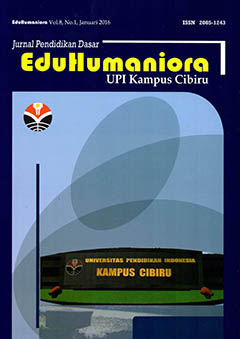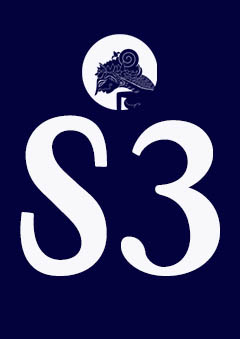THE USE OF SNAKES AND LADDERS MATH TO THE DEVELOPMENT OF MULTIPLE INTELLEGENCES IN ELEMENTARY SCHOOL MATHEMATICS SUMMATION MATERIALS
Abstract
Keywords
Full Text:
PDFReferences
Abidin, Zainal. 2017. "Development of Multiple Intelligences in Madrasahs." Elementary: Scientific Journal of Primary Education 3 (2): 120. https://doi.org/10.32332/elementary.v3i2.832.
Afandi, Rifki. 2015. "Development of Snakes and Ladders Game Learning Media To Improve Student Learning Motivation And Social Studies Learning Outcomes In Elementary Schools." JINoP (Journal of Learning Innovation). https://doi.org/10.22219/jinop.v1i1.2450.
Amir, Fauziah Azizah. 2020. "Development of Multiple Intelligences-Based Five Senses Teaching Materials in Grade I Elementary School Students." Pedagogic Journal of Islamic Elementary School 3 (1): 105–18. https://doi.org/10.24256/pijies.v3i1.1141.
Anshori, Muslich, and Sri Iswati. 2019. "Quantitative Research Methodology : Issue 1 - Google Books." Surabaya: UNAIR. https://books.google.co.id/books?hl=en&lr=&id=ltq0DwAAQBAJ&oi=fnd&pg=PR8&dq=variabel+penelitian+kuantitatif&ots=gLkOsmBU7m&sig=D_mwyRzRetoEePWr3gHBgPuLgdg&redir_esc=y#v=onepage&q=variabel quantitative research&f=false.
Badriah, Nurlailly, Fifiet Dwi, and Tresna Santana. 2021. "Learning Snakes and Ladders Games To Improve Mathematical Logic Intelligence." Cheerful Journal 4 (2): 212–17.
Chatib, Munif. 2015. "The School of Human Beings: A School Based On Multiple Intelligences In Indonesia - Munif Chatib - Google Books." https://books.google.co.id/books?id=tDJ9AwAAQBAJ&printsec=copyright&hl=id#v=onepage&q&f=false.
Fathani, Abdul Halim. 2016. "Rahmah Johar. ' PISA Problem Domain For Mathematical Literacy'. Journal of Opportunity , Volume 1, Number 1, October 2012. 136." EduSains Journal 4 (2): 136–50.
"Diary A Hamlahindong." n.d.
Legowo, Edy. 2017. "A Learning Model Based on Stimulation of Multiple Intelligences of Students." Journal of Guidance and Counseling Studies 2 (1): 1–8. https://doi.org/10.17977/um001v2i12017p001.
Masduki, Lusi Rachmiazasi, and Eem Kurniasih. 2017. "Development of the Sunda Manda Traditional Game Model in Improving Multiple Intelligences of Students And College Students." JIPMat 2 (2). https://doi.org/10.26877/jipmat.v2i2.1980.
Moran, Seana, Mindy Kornhaber, and Howard Gardner. 2006. “Orchestrating Multiple Intelligences Profile Students , Don ’ t Score Them” 64 (1): 22–27.
Musfiroh, Tadkiroatun. n.d. "The Nature of Multiple Intelligences," 1–60.
Nugrahani, Rahina, and The Department of Fine Arts. 2007. "Visual-Based Learning Media in the Form of Snakes and Ladders Games to Improve the Quality of Teaching and Learning in Elementary Schools." Educational Science Sheet 36 (1): 35–44.
Nurdiani, Yani. 2013. "Application of the Principle of Play While Learning in Developing Multiple Intelligences in Early Childhood Education (Case Study in PAUD Daarul Piqri, Leuwigajah Village, South Cimahi)." Empowerment 2 (2): 85–93.
On, Intelligences, and Matter Growth. 2013. "Multiple Intelligences-Based Student Worksheet Development On Growth And Development Materials." Journal of Biology Education 2 (3). https://doi.org/10.15294/jbe.v2i3.3098.
Sunartini, Fransisca Valeria. 2013. "Exploring the Academic Abilities of Me Learners." Humanika 13 (1): 50–64. https://doi.org/10.21831/hum.v13i1.3323.
Suwanto, Suwanto, and Ade Evi Fatimah. 2021. "Application of Multiple Intelligences in Mathematics Learning: Analysis on Musical Intelligence." Journal of Didactic Mathematics 1 (3): 144–50. https://doi.org/10.34007/jdm.v1i3.445.
Shaikhu, Ach. 2020. "Multiple Intelligences-Based Learning Strategies." Auladuna : Journal of Teacher Education Study Program Madrasah Ibtidaiyah 2 (2): 59–75. https://doi.org/10.36835/au.v2i2.416.
Urgència, I Tramitació D. 2017. "No Covariance Structure Analysis of Health-Related Indicators in Elderly Persons at Home with a Focus on Subjective Health Perceptions," 1–23.
Yusri, Muh. 2016. "Improving Children's Multiple Intelligences Through Traditional Bugis Games -Makassar," 219–22.
DOI: https://doi.org/10.17509/eh.v14i2.41164
Refbacks
- There are currently no refbacks.
Copyright (c) 2022 EduHumaniora | Jurnal Pendidikan Dasar Kampus Cibiru
EduHumaniora: Jurnal Pendidikan Dasar
Published in collaboration Program Studi PGSD UPI Kampus Cibiru
and
HDPGSDI
This work is licensed under a Creative Commons Attribution-ShareAlike 4.0 International License.















